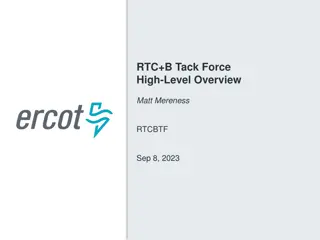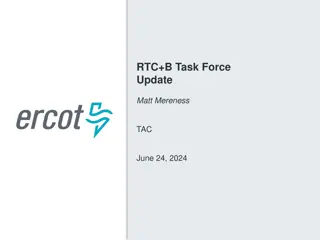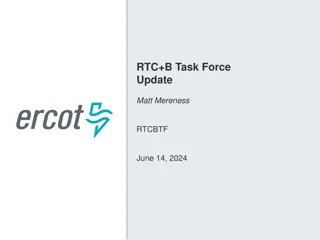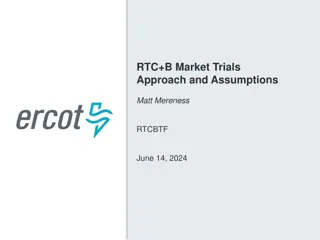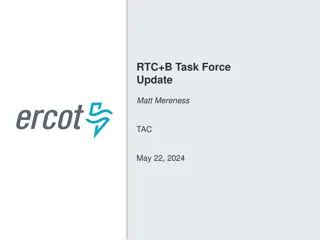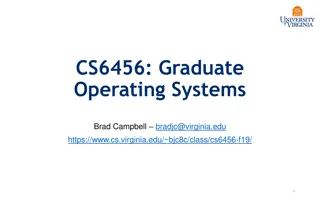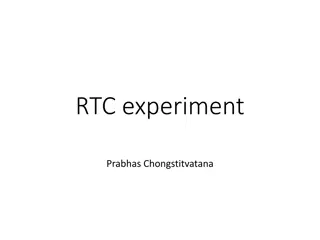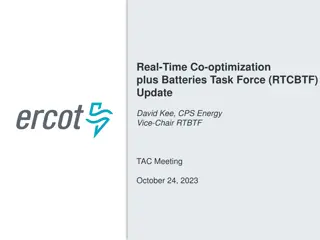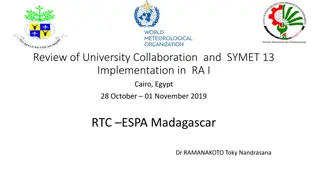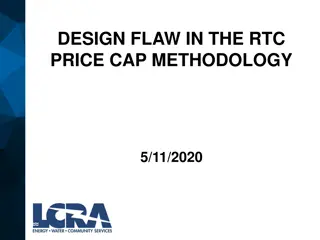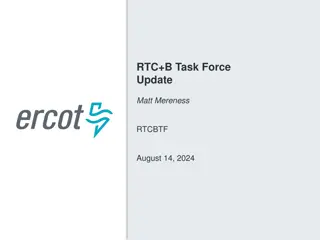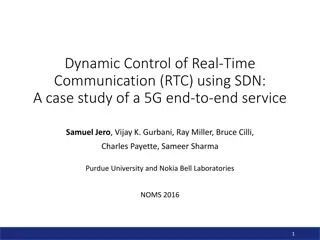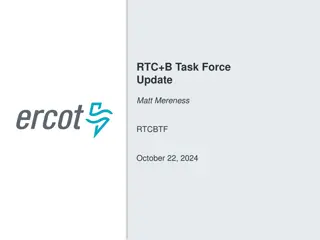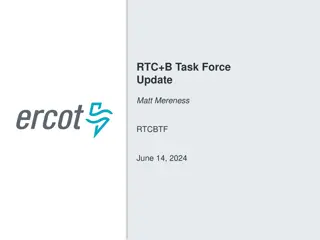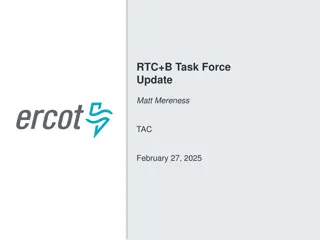
Ancillary Service Demand Curves for Real-Time Co-Optimization
"Learn about developing individual ancillary service demand curves and aggregate representations for optimal real-time co-optimization. Anticipate pricing outcomes and comply with PUCT NPRR 863 standards. Explore the methodology effective from March 1, 2020, including VOLL, SWOC, pricing caps, and maximum values for ASDCs. Discover the process of creating aggregate and individual curves for different ancillary services, such as Reg-Up, RRS, ECRS, and NSRS, with varying hourly requirements. Dive into the detailed analysis and considerations for efficient energy management."
Download Presentation

Please find below an Image/Link to download the presentation.
The content on the website is provided AS IS for your information and personal use only. It may not be sold, licensed, or shared on other websites without obtaining consent from the author. If you encounter any issues during the download, it is possible that the publisher has removed the file from their server.
You are allowed to download the files provided on this website for personal or commercial use, subject to the condition that they are used lawfully. All files are the property of their respective owners.
The content on the website is provided AS IS for your information and personal use only. It may not be sold, licensed, or shared on other websites without obtaining consent from the author.
E N D
Presentation Transcript
Item 3a Ancillary Service Demand Curves for Real-Time Co- Optimization Dan Jones August 9, 2019
Objective and Approach For RTC, produce individual ancillary service demand curves (ASDCs) that are, in aggregate, as consistent as possible with anticipated pricing outcomes for the ORDC methodology that will be effective March 1, 2020 Already specified by the PUCT: NPRR 863 AS Products (Reg-Up, RRS, ECRS, NSRS) VOLL = $9,000/MWh SWOC = $2,000/MWh Maximum ASDC value = $9,000/MWh (cover 0 to 2,000 MW of reserves) Maximum Energy Price (exclusive of congestion) capped at $9,000/MWh This presentation addresses the approach for: I. Developing an aggregate, single curve representation for the 2020 ORDC as a function of total online and offline reserves; and II. Dividing the single aggregate 2020 ORDC into individual ASDCs for Reg Up, RRS, ECRS and NSRS that vary by hour depending on the minimum AS requirements Separately, also need to develop a Reg-Down demand curve 2 PUBLIC
I. Developing an aggregate, single curve representation for the 2020 ORDC
Developing a Single 2020 ORDC Time period considered Jun 1, 2014 through Dec 31, 2018 Data considered at SCED granularity RTOLCAP RTOFFCAP X = 2,000 MW 2020 mu (??2020= 925) substituted for production mu 2020 sigma (?????2020= 1,213) substituted for production sigma Composite LOLP calculation used 0.5 1 ????? ??????? ?,0.5 ??2020,0.707 ?????2020 + 0.5 1 ????? ??????? + ???????? ?,??2020,?????2020 4 PUBLIC
Capacity levels < 10,000 MW Composite Price ($/MWh) + ?.? ? ????? ??????? + ???????? ?,???,???? ?.? ? ????? ??????? ?,?.? ???,?.??? ???? ???? ??? ?????? ??????,???? ~90k SCED intervals out of ~480k intervals examined where ??????? + ???????? < 10?? A locally estimated scatterplot smoothing (LOESS) regression curve was added to the data to create a smooth composite LOLP curve locally estimated scatterplot smoothing (LOESS) *System lambda is limited to $2,000 to be consistent with the maximum marginal cost of energy under RTC 5 PUBLIC
Capacity levels < 10,000 MW Extended Section To extend the curve to 2,000 MW of total reserves due to the absence of historical data points Used a system lambda of $493 which was the average system lambda for data points less than 4,000 MW of total reserves Assumed ???????? = 0?? This is in alignment with the existing process of setting RTOFFCAP = 0 once EEA Level 1 is initiated 6 PUBLIC
II. Dividing the single aggregate 2020 ORDC into individual ASDCs 7
Dividing the Aggregate ORDC into ASDCs: Approach Power Balance Penalty Curve Current scarcity pricing consists of the combination of ORDC and PBPC 10000 9000 8000 7000 PBPC is a proxy for a Reg- Up demand curve in the current design Penalty ($/MWh) 6000 5000 4000 Can use the PBPC to inform where to drop AS MW into the Aggregate ORDC curve 3000 2000 1000 0 0 50 100 Violation (MWh) 150 200 250 8 PUBLIC
Dividing the Aggregate ORDC into ASDCs Reg-Up RRS ECRS NSRS 175 2300 1268 107 Jul-19 HE22 NPRR 863 Requirements Step 1: Reserve 100 MW each of Reg-Up and RRS on aggregate ORDC consistent with PBPC pricing 9 PUBLIC
Dividing the Aggregate ORDC into ASDCs Reg-Up RRS ECRS NSRS 175 2300 1268 107 Jul-19 HE22 NPRR 863 Requirements Step 2: Place (??? ?? ??????????? 100??) at highest priced open MWs on the aggregate ORDC 10 PUBLIC
Dividing the Aggregate ORDC into ASDCs Reg-Up RRS ECRS NSRS 175 2300 1268 107 Jul-19 HE22 NPRR 863 Requirements Step 3: Place (??? ??????????? 100??) at highest priced open MWs on the aggregate ORDC 11 PUBLIC
Dividing the Aggregate ORDC into ASDCs Reg-Up RRS ECRS NSRS 175 2300 1268 107 Jul-19 HE22 NPRR 863 Requirements Step 4: Place ECRS Requirement at highest priced open MWs on the aggregate ORDC 12 PUBLIC
Dividing the Aggregate ORDC into ASDCs Reg-Up RRS ECRS NSRS 175 2300 1268 107 Jul-19 HE22 NPRR 863 Requirements Step 5: Place NSRS Requirement at highest priced open MWs on the aggregate ORDC 13 PUBLIC
Dividing the Aggregate ORDC into ASDCs Reg-Up RRS ECRS NSRS 175 2300 1268 107 Jul-19 HE22 NPRR 863 Requirements Step 6: Fill remaining MWs on the aggregate ORDC priced at >= $0.01 as NSRS ORDC reserves today are most similar to NSRS, so it seems appropriate to assign the remainder of the aggregate curve to that product (I.e., assigning it to other services would be more restrictive than the ORDC) 14 PUBLIC
Resulting ASDCs: July-19 HE22 Reg-Up RRS ECRS NSRS 175 2300 1268 107 Jul-19 HE22 NPRR 863 Requirements 15 PUBLIC
Resulting ASDCs: Feb-19 HE7 Reg-Up RRS ECRS NSRS 623 2840 690 1442 Feb-19 HE7 NPRR 863 Requirements While the underlying composite curve would remain unchanged, the individual ASDCs would adjust hourly to reflect the change in AS requirements 16 PUBLIC
Resulting ASDCs: Feb-19 HE7 Reg-Up RRS ECRS NSRS 623 2840 690 1442 Feb-19 HE7 NPRR 863 Requirements Non-Spin Requirement 17 PUBLIC
Comparison of the Two Example Hours Jul-19 HE22 Feb-19 HE7 18 PUBLIC
Comparison of the Two Example Hours 19 PUBLIC

